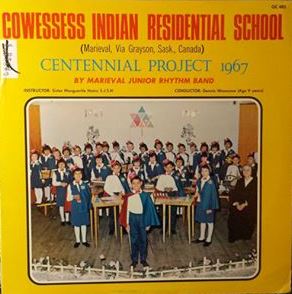 I recently was working with an audio recording from the Cowessess Indian Residential School. The recording was in the form of a seemingly professionally produced record featuring a musical ensemble of Cowessess IRS students. The recording was produced to celebrate the 1967 Canadian centennial. This particular item got me thinking about the handful of other material I’ve come across that relates to residential schools celebrating the Canadian centennial.
I recently was working with an audio recording from the Cowessess Indian Residential School. The recording was in the form of a seemingly professionally produced record featuring a musical ensemble of Cowessess IRS students. The recording was produced to celebrate the 1967 Canadian centennial. This particular item got me thinking about the handful of other material I’ve come across that relates to residential schools celebrating the Canadian centennial.
At the Shingwauk Residential School the centennial was incorporated in a variety of ways including:
- Students putting on the play ‘Arrow to the Moon’ which was written by a staff member.
- Participating in the local centennial celebrations, specifically in a local ‘Indian Pavilion’ focused on Indigenous people.
- Students created small handicrafts which were then sold at local centennial celebrations. Many of these crafts were seemingly token Indigenous in nature – eg. totem poles and west coast style woodwork.
This seemingly cheery participation in the centennial is a stark contrast to the federal celebrations and the Canadian Indian Pavilion at Expo 67. Created in consultation with Indigenous communities from across Canada the pavilion was designed to show the living conditions of Indigenous people in Canada and highlight the unfairness of Canadian government policies. The Pavilion included a graphic display of a life-sized portrait of an Indigenous family outside of their home with the caption “… and still, too many Indians are poor, sick, cold and hungry. Three out of every four Indian families earn $2,000 or less a year. The poverty line for the rest of Canadian families is $3,000 a year.”[1]
The Expo 67 pavilion was a drastic contrast to the official messaging around the success of the reserve system and residential schools. Unsurprisingly the pavilion was also very different to the celebratory centennial activities seen at residential schools.[2]
If anyone has come across other examples of the types of activities that were done in residential schools as part of the Canada celebration I would be interested in seeing them. They are odd little pieces of the residential school curriculum that highlight the assimilation based education and attempts to instill Canadian pride in IRS students.
[1] “Message for Canadians At Indian Pavilion”, Indian Record 30, no. 5 (1967): 15. Shingwauk Residential Schools Centre, Grey Nuns of Montreal Collection.
[2] For more information on Indigenous participation in Expo 67 see ““It’s Our Country”: First Nations’ Participation in the Indian Pavilion at Expo 67” by Myra Rutherdale and Jim Miller.
